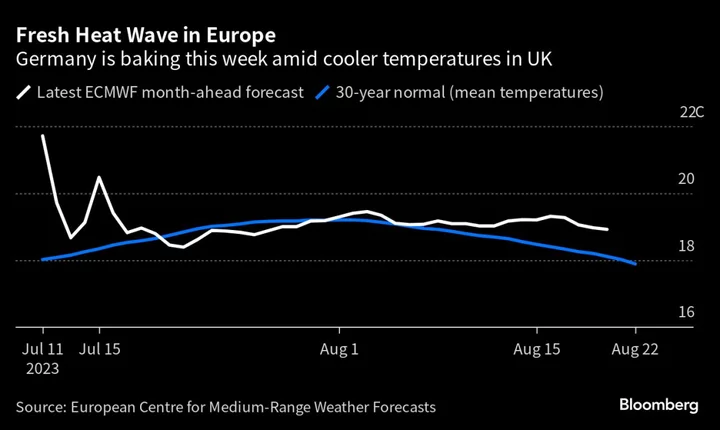
Heat Wave Bakes Large Swathes of Germany and Italy This Week
Scorching temperatures are blanketing parts of Germany and Italy this week, prompting heat warnings and straining the region’s
2023-07-11 16:51

xQc accuses Twitch of being lenient with Kai Cenat amid Kick rumors
The suspension and permanent ban procedures used by Twitch are not completely open to the public
2023-05-11 16:56

Kai Cenat: Streamer's 5 Twitch bans explained
Kai Cenat is known for the highest number of followers on the platform, but he was also banned five times
2023-05-13 19:24

Everything Amazon Announced at Its Fall Event: Echo, Fire TV, Ring, and More
Ahead of the holiday shopping season, Amazon today unveiled a refreshed lineup of smart home
2023-09-21 06:49

US judge pauses Microsoft's Activision buy
A US federal judge on Tuesday temporarily blocked Microsoft from completing its $69 billion buyout of gaming giant Activision Blizzard...
2023-06-14 10:16

Gigamon Channel Leaders Ashley McLean and Helena Marsikova Recognized on CRN’s 2023 Women of the Channel List
SANTA CLARA, Calif.--(BUSINESS WIRE)--May 8, 2023--
2023-05-08 22:29

These Stocks Are Moving the Most Today: Ford, Microsoft, Delta, Walgreens, Birkenstock, and More
The United Auto Workers union calls a surprise strike at Ford's Kentucky Truck Plant in Louisville, Microsoft is told by the IRS it owes $29 billion in back taxes, and Delta and Walgreens are scheduled to report quarterly earnings.
2023-10-12 16:58

Scientists develop powerful ‘pulses’ that can induce immediate ‘hibernation’ – and it could help us explore space
Scientists have developed new ultrasound technology that can induce immediate “hibernation”, they say. The system can be aimed at the head and bring on “torpor” a state similar to hibernation where mammals suppress their metabolism, reduce their body temperature and slow down other processes. The researchers behind the new system successfully brought it on in mice and rats, after pointing the ultrasound pulses at the animals’ heads. They suggest that it could work in humans – and might have important applications for long-distance space flight or medicine, they say. While further work is needed to understand how it might work on people, they suggest that it could be used when people have experienced acute emergencies or severe disease, for instance. If someone is in a car accident, for instance, they could essentially be put on ice until their organs are used for transplantation, for instance. It might also be useful in long journeys through space, where it would help reduce the amount of resources that people might stay alive if they are travelling to Mars or other distant locations. Mammals and birds keep high body temperatures and burn through a lot of energy. That characteristic is useful host of ways, but almost means that they require a lot of food and other resources. Some animals are able to limit the drawbacks of that situation by inducing torpor, which turns down many of those processes. It means that they use less energy, but are able to come back to living as normal after, without damage to their body. Humans are not able to do that. But if they were, it would be incredibly useful – which has led to the search for a noninvasive, safe and reliable way of inducing that state. The scientists found that directing ultrasound pulses at mice’s heads for around 10 seconds brought on the same conditions as torpor, with their heart rate slowing, their body temperature cooling and their metabolism slowing. They also built a special system that was able to measure that body temperature and send more of those pulses if a mouse appeared to be coming back to normal. Without that, however, the mice would wake back up again, returning to normal metabolism and body temperature. There are still a host of dangers, however. Experiments have shown that it is dangerous to bring animals back from those deep “torpid” states, and that they might not recover. If the mice were in cold environments, for instance, they did not spontaneously wake up. And any experiments in humans would be at risk of repeating those safety issues for people. The work is described in a new paper, ‘Induction of a torpor-like hypothermic and hypometabolic state in rodents by ultrasound’, published in Nature. Read More Apple lays bare danger of losing your health data What is Twitter Spaces and why did it go so wrong during DeSantis’s 2024 launch? Electric car range set to double with first production of breakthrough battery Apple lays bare danger of losing your health data What is Twitter Spaces and why did it go so wrong during DeSantis’s 2024 launch? Electric car range set to double with first production of breakthrough battery
2023-05-25 23:49

Nerdy Announces Second Quarter 2023 Financial Results
ST. LOUIS--(BUSINESS WIRE)--Aug 8, 2023--
2023-08-09 04:18

LEAK: New Storm Point POIs Are Coming to Apex Legends
A leak suggests new Storm Point POIs are coming in Apex Legends Season 19 after leakers found six new zones in the files.
2023-09-28 04:25

Indian foodtechs Zomato, Swiggy get notice for $90 million in unpaid taxes -CNBC TV18
BENGALURU India's top organization for indirect taxes has issued notices on unpaid taxes worth about 7.5 billion rupees
2023-11-22 18:54

SpaceX launch of Starship rocket on hold amid ‘mishap investigation’
SpaceX will not be cleared to launch its 400-foot-tall (121 metre) Starship rocket until a “mishap investigation” is completed, regulators have said. A statement from the Federal Aviation Administration (FAA) warned of a launch delay for the biggest rocket ever built, just hours after SpaceX boss Elon Musk said the craft was “ready to launch” on Wednesday. SpaceX made its first and only attempt at an orbital Starship launch in April, with the rocket exploding over the Gulf of Mexico just three minutes into the 90 minute flight. The crewless rocket broke up into pieces over an empty stretch of water, however the debris blast created by Starship’s huge engines at its launchpad drew heavy scrutiny from regulators. Concrete dust drifted more than 10 kilometres from the launch site, according to the Fish and Wildlife Service, while concrete chunks and metal shards were discovered within a 700-acre zone surrounding the pad. SpaceX claimed the mission was a success, as Starship and its Super Heavy booster were able to lift off on its maiden test flight, however the FAA launched an investigation soon afterwards. Following Mr Musk’s latest comments that the latest version of the rocket is ready to launch pending regulatory approval, the FAA warned SpaceX that it would need to wait for the investigation to conclude. “The SpaceX Starship mishap investigation remains open,” the FAA said in a statement. “The FAA will not authorise another Starship launch until SpaceX implements the corrective actions identified during the mishap investigation and demonstrates compliance with all the regulatory requirements of the licence modification process.” SpaceX has made numerous alterations and improvements to Starship and its launch pad, including remedial measures aimed at preventing launch debris and a new method for separating the upper stage from its booster rocket. Nasa has already awarded SpaceX a multi-billion dollar contract to develop Starship for its Artemis program, which aims to return humans to the surface of the Moon for the first time in more than 50 years. Mr Musk also plans to use the rockets for more ambitious longer term goals, including establishing a permanent human colony on Mars before 2050. “As the most powerful launch system ever developed, Starship will be able to carry up to 100 people on long-duration, interplanetary flights,” SpaceX notes on its website. “Starship will also help enable transport of many satellites, large space telescopes, and significant amounts of cargo to Earth orbit, the Moon, Mars and beyond.” Read More ‘It’s becoming like an airport’: How SpaceX normalised rocket launches SpaceX abandons YouTube for live streams of launches in favour of X/Twitter Starship ‘ready to launch’, Elon Musk says SpaceX crew streak across sky before splashing down off Florida coast SpaceX smashes rocket launch record as Musk eyes historic Starship mission
2023-09-07 21:49
You Might Like...

Walmart's top TV deal is back: Get a 65-inch QLED TV for under $400 ahead of Prime Day

SqlDBM Sponsors Data Innovation Summit to Engage the European Data Community

Best Prime Day 3D Printer Deals: Give Your Creativity a Boost for Less

This AI job application bot is on sale for 54% off

Apple TV Plus and other subscriptions get significant price increase

This Is Your Sign To Shop Outdoor Furniture On Amazon Prime Day

OpenAI CEO Sam Altman Says AI Is ‘Most Important Step Yet’ For Humans and Tech

Letitia James and 32 other attorneys general sue Meta for ‘harming youth’
